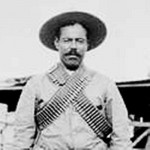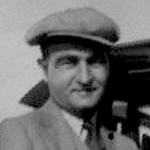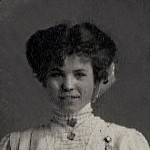fargo
 One day in mid 1916 or early 1917, my great uncle, John Spare, who would marry my great aunt, Mina Schumacher on January 8, 1921, was involved in an altercation along the Mexican border, while he was serving in Company B of the North Dakota National Guard. John had enlisted on June 30, 1916 at the age of just 17 years, and his company was assigned to the United States/Mexican border, as we were in the middle of a war with Mexico…really this was border patrol, because there were some pretty dangerous characters running around Mexico, terrorizing the people. One of the most notorious was Pancho Villa. The viciousness of José Doroteo Arango Arámbula…better known as Pancho Villa, was well documented. In a story told by a survivor of his first raid on March 7, 1916, the ruthlessness of this villain is made clear. Pancho Villa and 600 of his renegade followers rode into Columbus, Mexico (population 350) at four o’clock on that morning, riding horses and mules stolen from the Calvary at Camp Turlong just across the border. The camp was the headquarters for the 13th Calvary, and there were about 120 soldiers stationed there. Pancho and his men stole everything of value in the town, and set fire to all its buildings. Many merchants were killed, but the townspeople resisted so strongly that Pancho lost 100 men. He nevertheless, escaped to ride again and continue his raids on both sides of the border.
One day in mid 1916 or early 1917, my great uncle, John Spare, who would marry my great aunt, Mina Schumacher on January 8, 1921, was involved in an altercation along the Mexican border, while he was serving in Company B of the North Dakota National Guard. John had enlisted on June 30, 1916 at the age of just 17 years, and his company was assigned to the United States/Mexican border, as we were in the middle of a war with Mexico…really this was border patrol, because there were some pretty dangerous characters running around Mexico, terrorizing the people. One of the most notorious was Pancho Villa. The viciousness of José Doroteo Arango Arámbula…better known as Pancho Villa, was well documented. In a story told by a survivor of his first raid on March 7, 1916, the ruthlessness of this villain is made clear. Pancho Villa and 600 of his renegade followers rode into Columbus, Mexico (population 350) at four o’clock on that morning, riding horses and mules stolen from the Calvary at Camp Turlong just across the border. The camp was the headquarters for the 13th Calvary, and there were about 120 soldiers stationed there. Pancho and his men stole everything of value in the town, and set fire to all its buildings. Many merchants were killed, but the townspeople resisted so strongly that Pancho lost 100 men. He nevertheless, escaped to ride again and continue his raids on both sides of the border.
In haste, the United States sent soldiers to guard the borders. Unfortunately they were not well equipped,  because of the unpreparedness of the military machine at the time. Many of those men, including my great uncle’s company were sent down there without ammunition, and told that those who had ammunition would fight an attack if it came, while the others would dive under the bridge until the attack was over. They neglected to tell them that none of them had ammunition, and the men did not know that until all of them jumped under the bridge at the same time. It was then that the horrible truth was revealed. The hope, apparently, was to make Pancho think this was a large army to be reckoned with, in the hope that they would not try to attack them. They sorely misjudged the ruthlessness of this man, but the good news was that Pancho and his men were already in a gun fight with the 13th Calvary, so they took little notice of this small band of men hiding under the bridge, hoping that the villain and his men didn’t circle around and come back. I don’t know how long Great Uncle John was stationed there, but it is my guess that one day was too much…unless they were given some ammunition, that is.
because of the unpreparedness of the military machine at the time. Many of those men, including my great uncle’s company were sent down there without ammunition, and told that those who had ammunition would fight an attack if it came, while the others would dive under the bridge until the attack was over. They neglected to tell them that none of them had ammunition, and the men did not know that until all of them jumped under the bridge at the same time. It was then that the horrible truth was revealed. The hope, apparently, was to make Pancho think this was a large army to be reckoned with, in the hope that they would not try to attack them. They sorely misjudged the ruthlessness of this man, but the good news was that Pancho and his men were already in a gun fight with the 13th Calvary, so they took little notice of this small band of men hiding under the bridge, hoping that the villain and his men didn’t circle around and come back. I don’t know how long Great Uncle John was stationed there, but it is my guess that one day was too much…unless they were given some ammunition, that is.
Great Uncle John survived the war, and returned to Fargo, North Dakota, where he married my Great Aunt Mina. While he would still serve in the military for a long time, their lives would be happy and blessed with a daughter, Pauline Jessie Spare, who always went by Paula, on March 23, 1922. Pancho Villa continued to wreak havoc in Mexico, and along the border, until 1920, when he retired. For whatever reason, he was given a large estate, which he turned into a Military Colony for his formers Villistas, as his men a become known. Then, in  1923, Pancho decided to once again involve himself in Mexican politics, and on July 20, 1923, when he was killed by an assassin, who had probably been hired by the president of Mexico, Álvaro Obregón. When I read that Pancho Villa had been assassinated on this day in 1923, I remembered that Great Uncle John Spare had once had a close encounter with him, and I wondered how he and Great Aunt Min felt when they heard the news. Parral, Chihuahua, Mexico was a long way from Fargo, North Dakota, and a number of years had passed, so maybe they gave it little thought, or maybe they breathed a sigh of relief, knowing what kind of a man he was, and just how close Great Uncle John had come to losing his life that day, along the United States and Mexican Border.
1923, Pancho decided to once again involve himself in Mexican politics, and on July 20, 1923, when he was killed by an assassin, who had probably been hired by the president of Mexico, Álvaro Obregón. When I read that Pancho Villa had been assassinated on this day in 1923, I remembered that Great Uncle John Spare had once had a close encounter with him, and I wondered how he and Great Aunt Min felt when they heard the news. Parral, Chihuahua, Mexico was a long way from Fargo, North Dakota, and a number of years had passed, so maybe they gave it little thought, or maybe they breathed a sigh of relief, knowing what kind of a man he was, and just how close Great Uncle John had come to losing his life that day, along the United States and Mexican Border.
 My great aunt, Mina Albertine Schumacher, who went by Minnie as a child, but Min for most of her adult life, married John Clark Spare in Fargo, North Dakota on January 8, 1921. In the years preceding their marriage, John had enlisted in the North Dakota National Guard, Company B, at the age of 17 years. His company was assigned to the Rio Grande River Patrol on the Mexican border at Mercedes, Texas. Company B was patrolling one day, and John had an empty gun, because at that point, there was not enough ammunition to go around. Basically, the men who had loaded guns would have to cover the ones who did not, in the event of anything illegal happening along the border. I suppose that was the only thing that they could do, but I have to tell you that I would not feel very comfortable being one of those guys who did not have any ammunition at the border between Mexico and the United States. I realize that these days that border is probably more dangerous than it was then, but maybe not. Many of the outlaws from both countries ran to the other country to hide out from the law in their own country.
My great aunt, Mina Albertine Schumacher, who went by Minnie as a child, but Min for most of her adult life, married John Clark Spare in Fargo, North Dakota on January 8, 1921. In the years preceding their marriage, John had enlisted in the North Dakota National Guard, Company B, at the age of 17 years. His company was assigned to the Rio Grande River Patrol on the Mexican border at Mercedes, Texas. Company B was patrolling one day, and John had an empty gun, because at that point, there was not enough ammunition to go around. Basically, the men who had loaded guns would have to cover the ones who did not, in the event of anything illegal happening along the border. I suppose that was the only thing that they could do, but I have to tell you that I would not feel very comfortable being one of those guys who did not have any ammunition at the border between Mexico and the United States. I realize that these days that border is probably more dangerous than it was then, but maybe not. Many of the outlaws from both countries ran to the other country to hide out from the law in their own country.
On that day, John was patrolling near the bridge by the encampment, with his empty gun. Suddenly, a herd of horses was seen thundering toward them. Behind the herd was Pancho Villa and his gang of bandits. The gang was in a gun fight with the men from the Third Cavalry, from whom the gang had stolen the horses. The time had come for the border patrol to do their duty. It would be the job of the ones with the ammunition to engage the enemy and assist the Cavalry. The remainder of the men would need to dive under the bridge for cover. The men immediately prepared to take their necessary positions, and with one accord, all of the men of the border patrol dived under the bridge. Unbeknownst to the men, at least until that moment, they all had unloaded guns!! While that might seem like a funny thing to see all those men diving under that bridge because they did not have the ammunition to fight in the battle that was looming down on them, my guess is that it would also be a horrifying situation to the men hiding under the bridge hoping the battle would continue to go on down the road, and not circle back.
Following his time as part of the border patrol, John was called to the Guard full time, and assigned to guard the Fargo Armory, just as bombs were being placed at strategic points around the country to blow them up if it became necessary. I think it is a bit ironic that on his first assignment, John had no ammunition, and at his second assignment, when he was just going on 19 years of age, he was guarding a building that held larges stores of ammunition. I have to think that he must have thought to himself, “Where was all this ammunition when we were at the border?” John’s company would be taken into the Federal Army as the United States entered World War I. John would later re-enlist and fight in both world wars before he finally decided that he had served his time. I’m sure my Great Aunt Min was glad when he came home for good.
 My great grandfather, Carl Ludwig Theodor Schumacher, was born in the Province of Pommern in northern Germany, on May 23, 1859. He was one of the twelve children of Johann Freidrich Theodor Schumacher and Maria Maehling. He came to America after taking care of a wealthy landowners driving horses for several years beginning when he was 15. It was a job he loved very much, because he really loved horses. By the spring of 1884, he had saved enough money to pay for passage to America, with the plan of moving to Minnesota, where he had cousins.
My great grandfather, Carl Ludwig Theodor Schumacher, was born in the Province of Pommern in northern Germany, on May 23, 1859. He was one of the twelve children of Johann Freidrich Theodor Schumacher and Maria Maehling. He came to America after taking care of a wealthy landowners driving horses for several years beginning when he was 15. It was a job he loved very much, because he really loved horses. By the spring of 1884, he had saved enough money to pay for passage to America, with the plan of moving to Minnesota, where he had cousins.
Henriette Albertine Johanne Hensel was born in Schönwalde in the southern part of the Province of Pommern, in northern Germany on December 11, 1860. At the time she lived there all this land was part of the Prussian Empire. She was the second youngest of nine children of Carl Hensel and Henriette Tonn. Her father died before her younger brother was born in 1865. About that time, Henriette was sent to her older sister’s home to tend the 5 cows and 52 sheep she had. As time went on, she grew up and had a boyfriend…she was happy and content. Then everything changed for her. Her sister’s husband wanted to immigrate to America, and since Henriette was not married, her mother wanted her to go with them to help her with her two small daughters. She didn’t want to go, but she did go. The voyage was long, and the family spent much of it quite ill. Her sister’s husband never really recuperated fully, and he died just a few years later.
One Sunday a friend of Carl Schumacher’s asked him to sponsor at a baptism in his stead. At the baptism celebration, Carl met the mother of the baby, and her sister Henriette Hensel, who had both just recently come to America from Germany. For Carl, it was love at first sight, and he married the young lady just a year later in Belchester, Minnesota on November 12, 1886. Their marriage was blessed with seven children, Anna Louise (who became my grandmother), Albert August, Maria (who died at just three years of age), Mina Albertine, Frederick Carl, Bertha Emilie, and Elsa Ernestine.
About a year after Elsa was born, the family moved to a farm 12 miles from Lisbon, North Dakota. It was so different from Minnesota, and Albert, who was 15 at the time, fell in love with the wild country. In Minnesota he fished, but there was not much to hunt. Here there was lots to hunt, and guns quickly became Albert’s lifelong hobby. It was here, in 1910, that the family purchased their first surrey. It was a surrey with a fringed top. Anna married my grandfather, Allen Luther Spencer, then Albert married Christine Ida Froemke, and Mina was away at college in Fargo, finishing her high school. The neighbors started getting the new Model T car, and Albert had to have one, but Carl loved his horses, so he kept his surrey. Albert spent all of his spare time studying mechanics. Mina hated the farm, so Henriette wanted to make sure that her daughter received an education. In 1917, Henriette and Fred were both in bed with arthritis, but Henriette didn’t want Bertha to miss her senior year of high school, so she left her bed to care for Fred. After a few family meetings, they decided to leave Fred, who was feeling better now, to run the farm and the rest of the family moved to Fargo, North Dakota, where Carl and Henriette would spend the rest of their lives. Bertha graduated from Secretarial School and Elsa from high school. Mina married John Clark  Spare. Bertha married Arthur C Hallgren and Elsa married Frank Lawrence. Bertha and Elsa would not have children of their own, but would “adopt” their niece, Pauline Spare Holmberg’s children, Lisa, John, Kristen, and Julie. Between the four remaining children, Carl and Henriette would receive twenty one grandchildren, and a growing number of great grandchildren, great great grandchildren, and these days, great great great grandchildren. All this from a chance meeting when Carl stood in the stead of a sponsor who was unable to be there for a baptism…wow!!
Spare. Bertha married Arthur C Hallgren and Elsa married Frank Lawrence. Bertha and Elsa would not have children of their own, but would “adopt” their niece, Pauline Spare Holmberg’s children, Lisa, John, Kristen, and Julie. Between the four remaining children, Carl and Henriette would receive twenty one grandchildren, and a growing number of great grandchildren, great great grandchildren, and these days, great great great grandchildren. All this from a chance meeting when Carl stood in the stead of a sponsor who was unable to be there for a baptism…wow!!

